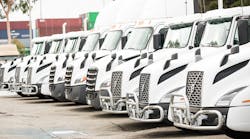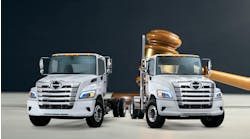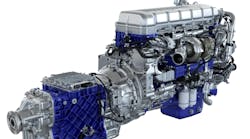California port trucking company replaces diesel fleet with CNG trucks
Alternative-fuel-powered trucks continue to catch on in California. Total Transportation Services Inc. (TTSI) is replacing its entire diesel fleet with near-zero emission natural gas trucks, the Los Angeles and Long Beach port trucking company announced.
The port drayage company now has 20 Volvo and 20 Freightliner Class 8 trucks equipped with the new Westport Cummins ISX12N Natural Gas engines. The purchase, which TTSI says is the largest buy of clean-engine technology of any fleet serving the ports of Los Angeles and Long Beach, is part of the company’s plan to have all of its fleet running on near-zero emissions by 2020.
During a typical month, 13,000 to 14,000 trucks drive in and out of at the two ports, emitting roughly 2,600 tons per year of smog-causing nitrogen-oxide emissions. TTSI’s 40 new near-zero-emission heavy-duty compressed natural gas (CNG) trucks would reduce this type of emissions by 90%, according to the nonprofit Coalition for Clean Air (CCA). When fueled with renewable natural gas, the trucks would reduce greenhouse gas emissions by more than 80%.
TTSI made the purchase announcement with CCA, they said, to raise awareness of the importance of natural and renewable gas trucking to help improve air quality and reduce greenhouse gas emissions in the Los Angeles region, particularly at these two busy California ports.
“If every one of the 14,000 trucks that call at these ports were changed to natural gas, it would have a major impact on air quality in the region,” said Vic LaRosa, president of TTSI. “We hope other haulers will follow our lead and make the switch as well.”
He added that the Westport Cummins engine is “ideally suited for use in the port drayage application.”
TTSI has already adopted alternative-fuel trucks into its fleet, including all-electric battery, hydrogen fuel-cell, and hybrid technologies. But the integration of the new natural gas engine is the fleet’s largest scale adaption of new fuel technologies.
“We are pleased to have partnered with TTSI on this order,” said Tom Swenson, manager for Cummins Natural Gas Group. “TTSI has once again demonstrated that remaining competitive in the Port drayage market and deploying near-zero and zero-emission technologies are not mutually exclusive.”
A quarter of TTSI’s investment in the new natural gas trucks was funded through the California Air Resources Board’s (CARB) California Climate Investments initiative, a statewide program that puts billions of cap-and-trade dollars to work reducing greenhouse gas emissions, strengthening the economy and improving public health and the environment — particularly in disadvantaged communities.
CARB's push in California
CARB’s Hybrid and Zero-Emission Truck and Bus Voucher Incentive Project (HVIP) has been making it easier for more California fleets to invest in alternative-fuel vehicles with less upfront cost, Tim Reeser, CEO and co-founder of Lightning Systems, told Fleet Owner earlier this month. His company offers Classes 3-6 electric powertrains used for delivery and food truck applications that qualify for up to $100,000 in HVIP vouchers in California. Some of the CARB funding was created out of Volkswagen’s emissions settlement, which required an investment of $800 million for zero-emissions projects.
“Southern California needs to reduce its smog-forming emissions by 45% before 2023 to meet federal standards,” said Dr. Joseph Lyou, president and CEO of CCA. “Replacing diesel engines with near-zero emission trucks would take us a long way toward meeting Environmental Protection Agency rules and avoiding the loss of federal highway funding.”
The EPA — prodded by CARB — proposed Phase 2 of its GHG regulations in 2016: Starting in 2021, it would require heavy-duty tractors to cut CO2 tailpipe emissions by another 24% by 2027 and vocational HD trucks to drop CO2 production by 16%.
CARB has been calling for even lower ambient air tailpipe emissions. Late last year, the EPA released a proposed Cleaner Truck Initiative that would cut diesel NOx from its current 0.2 g/bhp-hr. level to 0.02. The timetable for the reduction isn’t expected until 2020 when the EPA says it will issue a final rule.
Back in January, Kenworth and Toyota announced plans to develop 10 electric hydrogen fuel cell heavy-duty trucks for the southern California market. The Toyota-Kenworth partnership is part of a $41 million zero and near-zero emissions freight facilities (ZANZEFF) grant awarded by the California Air Resources Board.
“The performance of the 10 Kenworth heavy-duty trucks being developed under this program is targeted to meet or exceed that of a diesel, while producing water as the only emissions byproduct,” Mike Dozier, general manager of Kenworth, said in April at a Port of Los Angeles event to show off one of the trucks.
Eventually, these fuel cell trucks would move cargo from the Los Angeles and Long Beach ports throughout the Los Angeles area, the Inland Empire, the Port of Hueneme and eventually to Merced. The trucks will be operated by TTSI along with Toyota Logistics Services, UPS, and Southern Counties Express.
Michelle Buffington of CARB applauded the TTSI’s move from diesel. “TTSI’s commitment to switch their fleet to 100% clean natural gas, battery-electric, and hydrogen fuel cell vehicles help bring advanced technologies to market scale deployment–technologies that are needed to meet our state air quality goals,” she said.
Southern California Gas Co. (SoCalGas) has been promoting the switch to natural gas heavy-duty trucks for years, according to Yuri Freedman, the company’s senior director of business development. He said the energy company has helped companies replace at least 550 diesel trucks with natural gas trucks. "That equates to taking about 30,000 cars off of California’s roads," Freedman said.
SoCalGas, along with environmental health non-profit Breathe LA, fueling company Clean Energy, engine manufacturer Cummins Westport, and CARB participated in the announcement on Sept. 26.
“This purchase also confirms TTSI’s commitment to taking a leadership position in the maritime industry and will hopefully help the ports meet their zero-emission goals spelled out in the recent update to the San Pedro Bay Clean Air Action Plan,” TTSI’s LaRosa said.




